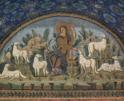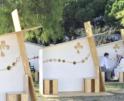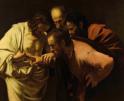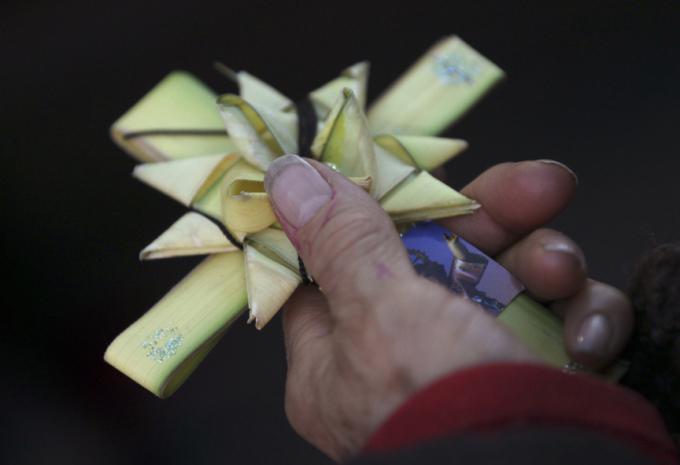
Faith
Since 1969, when the Vatican published new liturgical norms and the three-year cycle of readings, this particular Sunday is now called "the Fifth Sunday of Lent," and the Gospel readings used in antiquity have been restored.
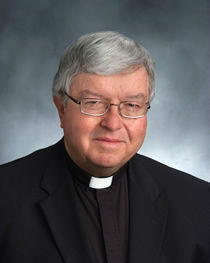
Doyle
Q. When I was growing up, we celebrated Passion Sunday and the statues in church were covered with purple cloths. (As I remember, that symbolized Jesus' hiding himself from the view of those who would soon crucify him.) Then, a week later, it was Palm Sunday, and we received the blessed palms.
The following weekend, we celebrated Easter. But for several years now, our parish has marked Passion Sunday and Palm Sunday on the same day, one week before Easter -- and the statues are no longer covered.
So my question is this: When did these two Sundays become one, and why? (Indiana)
A. You are correct that, up until 1969, the Church celebrated "Passion Sunday" two weeks before Easter. A passion narrative was read as the Gospel passage for that day, and the Church began to turn its focus to the sufferings of Jesus.
Since 1969, when the Vatican published new liturgical norms and the three-year cycle of readings, this particular Sunday is now called "the Fifth Sunday of Lent," and the Gospel readings used in antiquity have been restored.
The purpose of the change, as I understand it, was to be able to devote the first five weeks of Lent, as it was in the Church's early history, to the preparation of catechumens for entrance into the Church at Easter.
One vestige of the former calendar remains: Beginning on the Fifth Sunday of Lent, the practice of covering crosses and images in the church is permitted. (Note that it is "permitted," not mandated; discretion is given to the local pastor.)
Images (statues of saints, for example) are uncovered after the start of the Easter Vigil; crosses are unveiled on Good Friday, when the faithful are invited to venerate the cross.
I have never heard the explanation you propose for veiling the cross -- namely, that Jesus is "hiding" from those who would crucify him. The reason most commonly offered is that the veils represent a sort of "fasting" from the sacred depiction of what ultimately led to the glory of our salvation.
Q. Could you explain for me the difference (if any) between "priest" and "monsignor?" Under what circumstances is a priest given the title of "monsignor?" (Burke, Virginia)
A. "Monsignor" is a title bestowed on a priest who has distinguished himself by exceptional service to the church. It is a title granted by the pope -- typically, upon the recommendation of the priest's diocesan bishop. It is a purely honorary title and has no effect on the priest's duties or ministerial assignment.
Nearly 50 years ago, the Priests' Senate in my own diocese passed a resolution asking that our bishop no longer name any priests as monsignors. As I recall our discussion, we felt that it was a medieval and inappropriate title (it derives from the Italian words meaning "my Lord") and that its bestowal could cause hard feelings -- not so much with priests who were passed over, but among parishioners whose own pastor had not been so honored.
So it was with some satisfaction that I noticed, in January 2014, that Pope Francis had instructed the bishops of the world that diocesan priests would no longer be awarded the title before reaching the age of 65. No reasons were published for the pope's decision, but Pope Francis has often cautioned priests against careerism and personal ambition.
He seems to have long felt uncomfortable about ecclesiastical titles; when he was a bishop and later a cardinal in Argentina, Pope Francis always asked people to call him "Father." And notably, while he served as archbishop of Buenos Aires (1998-2013), not once did he petition the Holy See to have one of his priests named a monsignor.
- Father Kenneth Doyle is a columnist for Catholic News Service
Recent articles in the Faith & Family section
-
Scripture Reflection for April 21, 2024, Fourth Sunday of EasterJem Sullivan
-
The new Temple: How Easter changes religionDr. R. Jared Staudt
-
The wonder of Ordinary TimeLucia A. Silecchia
-
Is there still responsibility for past sins after confession?Jenna Marie Cooper
-
Wounds, not scarsJaymie Stuart Wolfe

